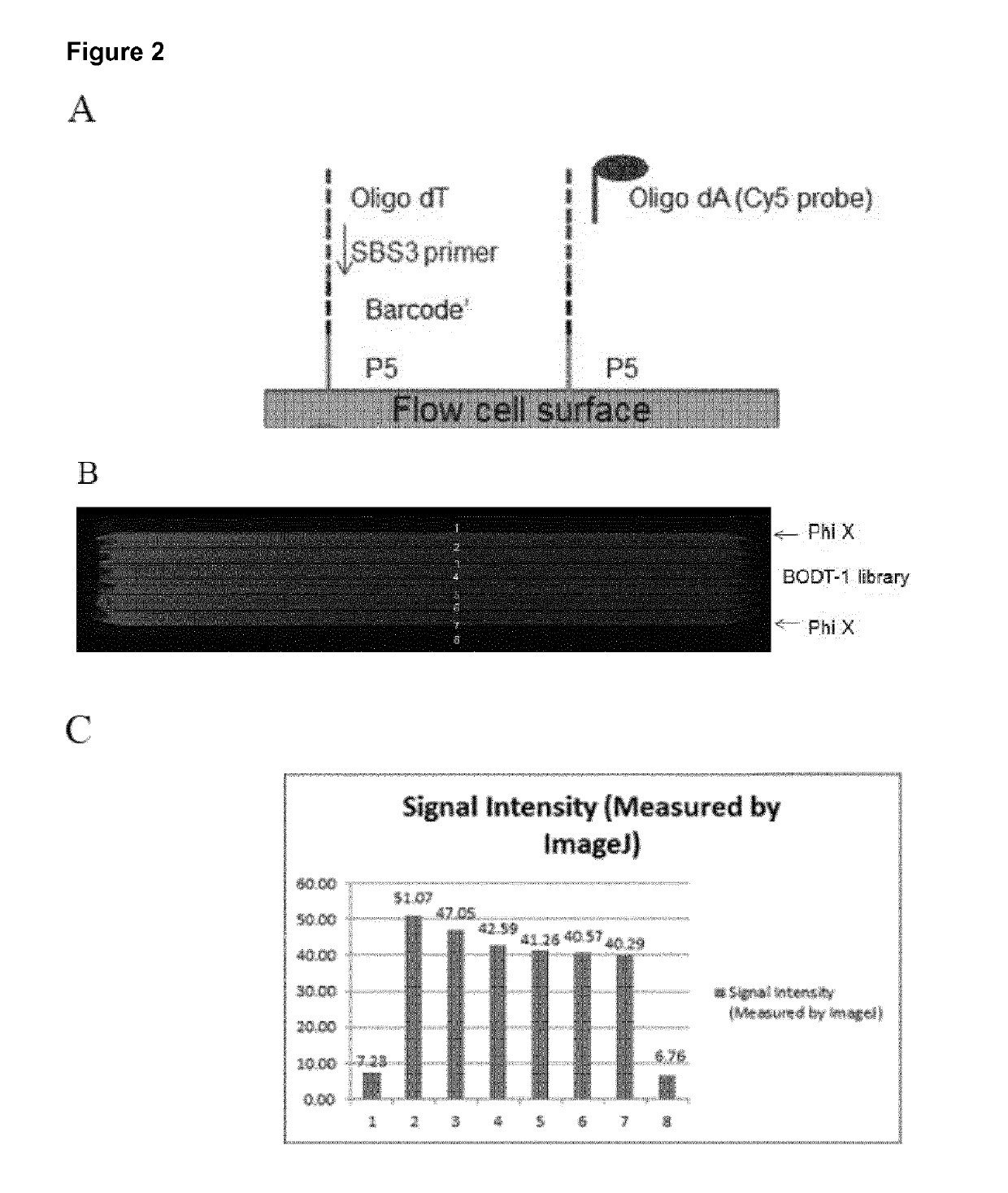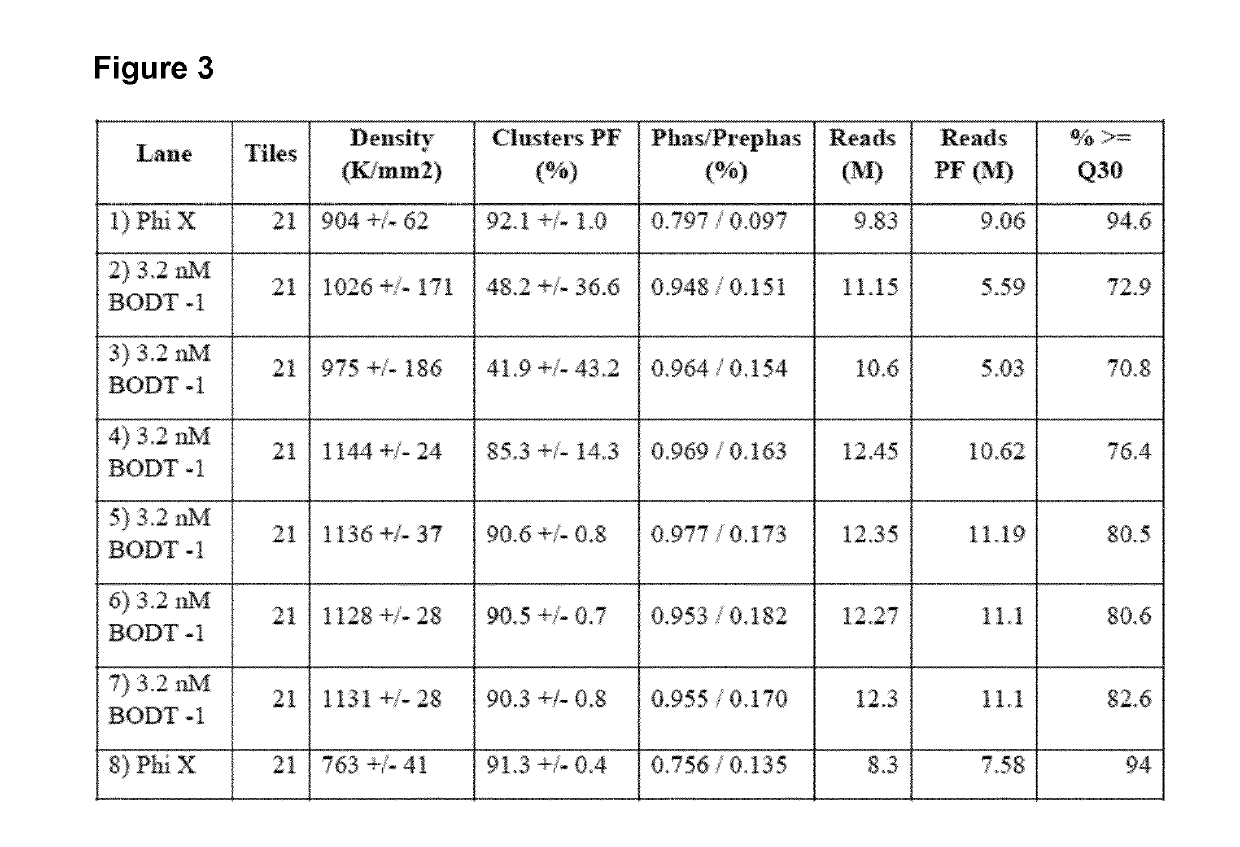Spatially distinguished, multiplex nucleic acid analysis of biological specimens
- Summary
- Abstract
- Description
- Claims
- Application Information
AI Technical Summary
Benefits of technology
Problems solved by technology
Method used
Image
Examples
example i
Spatially Tagging mRNA from a Tissue Sample Using Illumina Flow Cells
[0129]A method for generating barcoded oligo-dT containing clusters, then revealing the barcoded oligo-dT with a restriction enzyme digest followed by sequencing is described in FIG. 1. A library of fragments containing a single stranded, barcoded oligo-dA, P5′,P7, SBS3 sequencing primer binding site and a BspH1 restriction enzyme site (shown in the top panel of FIG. 1) were prepared by oligo synthesis (Integrated DNA Technologies). The barcodes were 27mers and were randomly generated during synthesis. The binding site for the SBS3 sequencing primer was included for decoding of the barcode by sequencing. An oligo-dA stretch was included to generate an oligo dT site upon clustering and linearization. Bridge amplification and clustering were performed according to standard cluster chemistry (Illumina TruSeq PE Cluster Kit v3 cBot P / N: 15037931) on an Illumina GA flow cell using manufacture's recommended protocol.
[013...
example ii
Cell Adhesion on Illumina Flow Cells
[0134]Single cells were captured on a patterned flow cell (HiSeq X10 flow cell, Illumina). All reagent flow steps were performed using a peristaltic pump or the cBOT cluster generation instrument (Illumina). Briefly, nuclease free water was flowed on all lanes of the patterned flow cell followed by 30-70K Poly D Lysine Solution (100 μg / ml and 20 μg / ml) at a flow rate of 100 μl / min for 8 min. Heat inactivated Fetal Bovine Serum (Life Technologies #10082-139) was also tested as an adhesive. The adhesives were incubated on the flow cell lanes for 1 hr, followed by a 1× PBS+0.5% Pluronic F-68 (Life Technologies #24040-032) wash. Next, the cells were adhered to the coated flow cells by flowing 5 to 50 cells / μl or approximately 100-1000 cells per lane at a rate of 100 μl / min, followed by an incubation step for 60 min to bind the cells. The flow cell was washed with 1× PBS / 0.5% pluronic at a rate of 75 μl / min. If cells were fixed on the flow cell, 1% Par...
example iv
Spatially Localized Capture of Target mRNA by Probes Attached to a BeadArray™ Surface
[0140]This example describes placement of tissue slices on top of a BeadArray™ having poly T probes, release of RNA from the tissue sections, capture of the released mRNA by the poly T probes, reverse transcription to Cy5 label the poly T probes, removal of the tissue and imaging of the BeadArray™.
[0141]As shown in Panel A of FIG. 8, a mouse olfactory tissue section was placed on a BeadArray™ having polyT probes. The tissue was treated to release mRNA and poly A tails of the released mRNA were hybridized to poly T sequences of the probes. The poly T sequences were extended using the captured mRNAs as templates and the extended primers were selectively labeled with Cy5. The tissue was removed from the BeadArray™ and the BeadArray™ was imaged to detect Cy5 flourescence.
[0142]As shown in Panel B of FIG. 7, areas of the BeadArray™ that were proximal to areas of the tissue that released mRNA species appe...
PUM
| Property | Measurement | Unit |
|---|---|---|
| Length | aaaaa | aaaaa |
| Length | aaaaa | aaaaa |
| Diameter | aaaaa | aaaaa |
Abstract
Description
Claims
Application Information
 Login to View More
Login to View More - R&D
- Intellectual Property
- Life Sciences
- Materials
- Tech Scout
- Unparalleled Data Quality
- Higher Quality Content
- 60% Fewer Hallucinations
Browse by: Latest US Patents, China's latest patents, Technical Efficacy Thesaurus, Application Domain, Technology Topic, Popular Technical Reports.
© 2025 PatSnap. All rights reserved.Legal|Privacy policy|Modern Slavery Act Transparency Statement|Sitemap|About US| Contact US: help@patsnap.com



